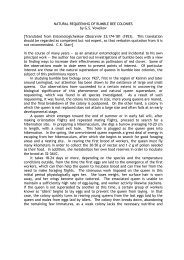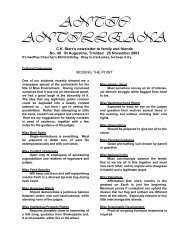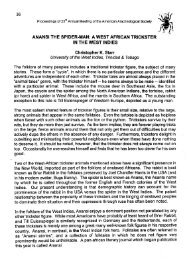A Love Affair with a Tropical Island: Dave Hardy and the ... - ckstarr.net
A Love Affair with a Tropical Island: Dave Hardy and the ... - ckstarr.net
A Love Affair with a Tropical Island: Dave Hardy and the ... - ckstarr.net
Create successful ePaper yourself
Turn your PDF publications into a flip-book with our unique Google optimized e-Paper software.
A <strong>Love</strong> <strong>Affair</strong> <strong>with</strong> a <strong>Tropical</strong> <strong>Isl<strong>and</strong></strong>: <strong>Dave</strong> <strong>Hardy</strong> <strong>and</strong> <strong>the</strong><br />
Struggle to Know Tobago’s Biota<br />
Jerry David <strong>Hardy</strong> is well known<br />
in our region for his long-time, passionate<br />
interest in <strong>the</strong> isl<strong>and</strong> of<br />
Tobago <strong>and</strong> its biota. During a<br />
recent stay <strong>with</strong> him in Tobago, we<br />
found that he is known all over <strong>the</strong><br />
isl<strong>and</strong>. Speaking <strong>with</strong> a fisherman<br />
in Speyside one day, we noted <strong>the</strong><br />
man’s near-amazement to learn that<br />
our companion was none o<strong>the</strong>r than<br />
<strong>the</strong> legendary “Snake Man”. <strong>Dave</strong>’s<br />
main scientific expertise is in <strong>the</strong><br />
systematics of fishes, amphibians<br />
<strong>and</strong> reptiles, <strong>and</strong> his paper on Tobago’s<br />
biogeography (<strong>Hardy</strong> 1982)<br />
remains <strong>the</strong> definitive work in that<br />
area. The following biographical<br />
article is mostly drawn from an interview<br />
conducted in Trinidad on 27<br />
November, 2007.<br />
<strong>Dave</strong> was born in 1929 in Pennsylvania,<br />
USA. After just three days,<br />
<strong>the</strong> <strong>Hardy</strong> family - parents, older sister <strong>and</strong> <strong>the</strong> infant <strong>Dave</strong><br />
- moved to 22 Wade Avenue on <strong>the</strong> outskirts of Baltimore,<br />
Maryl<strong>and</strong>, <strong>the</strong> house where he still lives today. He blames<br />
himself for <strong>the</strong> Great Depression, which began in 1929.<br />
“My mo<strong>the</strong>r took one look at me, got all depressed, <strong>and</strong> it<br />
just sort of spread from <strong>the</strong>re.”<br />
His fa<strong>the</strong>r had a master’s degree in Biology from Johns<br />
Hopkins University in Baltimore. An episode from <strong>the</strong><br />
Depression illustrates something of <strong>the</strong> times <strong>and</strong> <strong>the</strong> elder<br />
Mr. <strong>Hardy</strong>’s personal philosophy. “Despite his background<br />
in science, my fa<strong>the</strong>r began work as a Methodist minister.<br />
There was massive unemployment at <strong>the</strong> time, <strong>and</strong> he lost<br />
that job. He wound up making yeast for a whiskey distillery,<br />
<strong>the</strong> only job he could find. However, he still wanted to be<br />
involved in <strong>the</strong> Methodist Church, <strong>and</strong> one day he applied to<br />
become a deacon. He was told that he wasn’t acceptable as<br />
a deacon as long as he was involved in making whiskey, so<br />
he immediately quit his job at <strong>the</strong> distillery. My mo<strong>the</strong>r was<br />
not pleased, in fact utterly devastated. And she wasn’t <strong>the</strong><br />
only member of <strong>the</strong> family who disapproved of my fa<strong>the</strong>r’s<br />
decision, I can assure you. Jobs were very hard to come by<br />
at that time, <strong>and</strong> I think we lived on nothing but cornmeal<br />
Christopher K. Starr 1 <strong>and</strong> Jo-Anne N. Sewlal 2<br />
Dept. of Life Sciences, University of <strong>the</strong> West Indies,<br />
St. Augustine, Trinidad <strong>and</strong> Tobago.<br />
<strong>ckstarr</strong>99@gmail.com<br />
joannesewlal@gmail.com<br />
J. David <strong>Hardy</strong> in front of a laboratory at <strong>the</strong> Chesapeake<br />
Biological Laboratory in Maryl<strong>and</strong>, where he<br />
once worked. The laboratory is named for his mentor<br />
in herpetology, <strong>the</strong> late Romeo Mansuetti.<br />
52<br />
mush for at least six months. Just<br />
by dumb luck, though, in about six<br />
months he got a job as head of <strong>the</strong><br />
YMCA in Baltimore, a very good<br />
job in those days.”<br />
Surprisingly, his fa<strong>the</strong>r’s training<br />
in biology had no apparent<br />
influence on <strong>Dave</strong>’s own career<br />
path. As a child he aspired to be an<br />
airplane pilot, <strong>and</strong> for a time later in<br />
life he had a small plane of his own.<br />
Even so, he gained an interest in<br />
amphibians <strong>and</strong> reptiles at an early<br />
age. “There are certain definitive<br />
moments that change your whole<br />
life, even if you don’t realize it at<br />
<strong>the</strong> time. When I was 11 years old<br />
both of my parents were working.<br />
What should <strong>the</strong>y do <strong>with</strong> my sister<br />
<strong>and</strong> me in <strong>the</strong> summer time, when<br />
we were not in school? One day at<br />
breakfast <strong>the</strong>y saw an advertisement<br />
for a summer nature school at Druid Hill Park in Baltimore,<br />
<strong>and</strong> that seemed to be <strong>the</strong> solution. So, I was at Druid Hill<br />
Park every weekday that summer, <strong>and</strong> it was <strong>the</strong>re that I met<br />
Romeo Mansuetti.<br />
“Romeo was 18 years old <strong>and</strong> absolutely intrigued by<br />
amphibians <strong>and</strong> reptiles. Soon he had me hooked on herpetology,<br />
<strong>and</strong> I have been that way ever since. Before I met<br />
Romeo, I was scared to death of snakes, so that is definitely<br />
<strong>the</strong> beginning of my interest in herpetology. He motivated<br />
me to overcome my fear, so that a couple of years later I<br />
was catching [venomous] copperheads.”<br />
“Even now, though, I have a reflexive reaction if I<br />
come upon a snake suddenly. If I am out turning over logs,<br />
where I expect to find snakes, that’s okay, but if I am walking<br />
along at night <strong>and</strong> suddenly <strong>the</strong>re is a snake on <strong>the</strong> trail,<br />
I go ‘Aaahhh!!’. And <strong>the</strong>n I realize I shouldn’t do that,<br />
especially in Tobago, where all snakes are harmless.”<br />
<strong>Dave</strong> was in <strong>the</strong> U.S. Army <strong>and</strong> <strong>the</strong>n did his undergraduate<br />
degree at Elon College [now Elon University] in<br />
North Carolina. After that he was in graduate school at <strong>the</strong><br />
University of Maryl<strong>and</strong>, although he left <strong>with</strong>out completing<br />
his PhD. For many years he has worked for <strong>the</strong> National
J. David <strong>Hardy</strong> <strong>and</strong> Tobago’s Biota<br />
53<br />
Oceanographic & Atmospheric Administration (NOAA)<br />
in Washington. However, since <strong>the</strong> early 1990s his base<br />
has been <strong>the</strong> Division of Fishes of <strong>the</strong> National Museum<br />
of Natural History (NMNH), Smithsonian Institution, even<br />
as he continues as an NOAA employee. His job is to help<br />
develop <strong>the</strong> Integrated Taxonomic Information System<br />
(ITIS), which is intended to list every scientific name of <strong>the</strong><br />
entire world’s biota.<br />
<strong>Dave</strong> first came to Tobago in <strong>the</strong> early 1960s, while still<br />
a graduate student. The story of his first encounter is best<br />
told in his own words.<br />
“I had come to Trinidad <strong>with</strong> a Smithsonian group led<br />
by Bob Tuck. Somebody said we should go to Tobago. I<br />
didn’t really want to go, but Ja<strong>net</strong> Olmon thought it sounded<br />
wonderful <strong>and</strong> persuaded me. And I fell in love <strong>with</strong> <strong>the</strong><br />
place, right <strong>the</strong>n <strong>and</strong> <strong>the</strong>re. We kept seeing things that we<br />
hadn’t seen in Trinidad. We didn’t know what <strong>the</strong>y were,<br />
but we knew <strong>the</strong>y were different. I never bo<strong>the</strong>red much<br />
<strong>with</strong> Trinidad after that.”<br />
“That first Tobago trip was ano<strong>the</strong>r defining moment in<br />
my life. In Trinidad, Ja<strong>net</strong> <strong>and</strong> I had been collecting Mannophryne<br />
trinitatis, commonly known as <strong>the</strong> yellow-throated<br />
frog. It has a distinctive call, ‘pidip pidip pidip pidip’, familiar<br />
to anyone who goes into <strong>the</strong> forest in <strong>the</strong> rainy season.<br />
We were in Tobago, walking around in <strong>the</strong> forest, <strong>and</strong> Ja<strong>net</strong><br />
said ‘<strong>Dave</strong>, stop. Listen.’ What was I listening to? What<br />
Ja<strong>net</strong> had noticed - although I had not - was that in Tobago<br />
<strong>the</strong> yellow-throats were going ‘peep peep peep peep’, not<br />
‘pidip pidip pidip pidip’. And that is why, when I came to<br />
describe <strong>the</strong> Tobago yellow-throat as a new species, I named<br />
it after her, Colostethus olmonae [now Mannophryne olmonae,<br />
<strong>the</strong> Bloody Bay poison frog].”<br />
“You might say that hearing that ‘peep peep peep peep’<br />
was a defining moment <strong>with</strong>in <strong>the</strong> larger defining moment of<br />
my first encounter <strong>with</strong> Tobago. I said to myself that this was<br />
<strong>the</strong> place to be. Since <strong>the</strong>n we have discovered three more<br />
undescribed frogs in <strong>the</strong> isl<strong>and</strong>. I have been back between<br />
40 <strong>and</strong> 50 times, I would estimate, on average a little more<br />
than once a year.”<br />
<strong>Dave</strong> has also visited several o<strong>the</strong>r Caribbean isl<strong>and</strong>s,<br />
beginning <strong>with</strong> Cuba in 1947. Then, from 1962 into <strong>the</strong><br />
1970s he worked in <strong>the</strong> Lesser Antilles. Part of what persuaded<br />
him initially to visit Tobago was one particular<br />
puzzle. He had seen frogs identified as Eleu<strong>the</strong>rodactylus<br />
urichi on Grenada <strong>and</strong> <strong>the</strong>n on Trinidad. They were clearly<br />
different, so he wanted to see what was present on Tobago.<br />
While some Tobago specimens matched those from Trinidad,<br />
o<strong>the</strong>rs were <strong>the</strong> same in some characters but not all.<br />
Later analysis by <strong>Dave</strong> <strong>and</strong> o<strong>the</strong>rs showed that what had been<br />
treated as one species was, in fact, a complex. E. urichi is<br />
present on both isl<strong>and</strong>s, while E. charlottevillensis is a Tobago<br />
endemic, <strong>and</strong> E. euphronoides is a Grenada endemic.<br />
(All are now being placed in <strong>the</strong> genus Pristimantis).<br />
Thus <strong>Dave</strong> was led into a broader study of <strong>the</strong> amphibians<br />
<strong>and</strong> reptiles of Tobago, which by stages has become a<br />
major project to inventory <strong>the</strong> entire biota of <strong>the</strong> isl<strong>and</strong>.<br />
“In 1979 I got some funding from <strong>the</strong> Organization of<br />
American States <strong>and</strong> EarthWatch, <strong>and</strong> <strong>the</strong>re has been various<br />
o<strong>the</strong>r external support. The Tobago House of Assembly<br />
(THA) contributed TT$3000. However, I have financed<br />
<strong>the</strong> greater part of it, myself. I estimate that I have spent<br />
something more than US$200,000 of my own money over<br />
<strong>the</strong> years. I have no dependents or expensive tastes, so that<br />
I can afford to devote a large part of my earnings to my life’s<br />
work, <strong>the</strong> Tobago project.”<br />
Naturally, a project of this magnitude is not <strong>the</strong> work of<br />
one man. <strong>Dave</strong> has been able to draw many collaborators<br />
into it, specialists in various groups of organisms. Many of<br />
<strong>the</strong>se have visited Tobago on trips that he led.<br />
“The best trip of all was in 1991. Several people from<br />
<strong>the</strong> Smithsonian’s Division of Fishes came down, as well as<br />
<strong>the</strong> crustacean specialist Marilyn Schotte, all outst<strong>and</strong>ing in<br />
<strong>the</strong>ir various fields. They discovered a number of new species<br />
of fishes <strong>and</strong>, I think, about 20 new crustaceans. Aside<br />
from being very productive, it was an extremely enjoyable<br />
trip, as everyone got along well toge<strong>the</strong>r.”<br />
The project has also benefited from association <strong>with</strong><br />
a number of local people in both isl<strong>and</strong>s. In Tobago <strong>the</strong>se<br />
have included <strong>the</strong> late Jane Boyle, Earl Caesar (former head<br />
of Fisheries for Tobago) <strong>and</strong> Pat Turpin. “Some years ago I<br />
spent a week <strong>with</strong> Jane Boyle working on mollusks. She was<br />
very dedicated, but she didn’t keep precise locality data, so<br />
all we know for sure about her specimens is that <strong>the</strong>y came<br />
from somewhere around Tobago.”<br />
The main goal of <strong>the</strong> project is annotated lists of <strong>the</strong><br />
biota of Tobago, several parts of which are now published<br />
(e.g. Peck et al. 2002) or close to completion. An important<br />
auxiliary goal is a comprehensive electronic bibliography<br />
of <strong>the</strong> natural history of Tobago, amounting to about 7500<br />
references.<br />
REFERENCES<br />
<strong>Hardy</strong>, D. J. 1982. Biogeography of Tobago, West Indies, <strong>with</strong><br />
special reference to amphibians <strong>and</strong> reptiles: a review. Bulletin of<br />
<strong>the</strong> Maryl<strong>and</strong> Herpetological Society, 18: 37-142.<br />
Peck, S. B., Cook J. <strong>and</strong> <strong>Hardy</strong>, J. D. 2002. Beetle fauna of<br />
<strong>the</strong> isl<strong>and</strong> of Tobago, Trinidad <strong>and</strong> Tobago. Insecta Mundi, 16:<br />
9 - 23.








